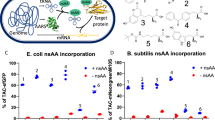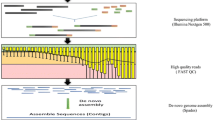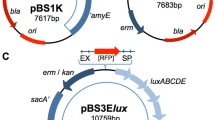Abstract
The advent of genomics has greatly influenced fundamental and applied microbiology. This has become paradigmatic in the case of Bacillus subtilis, a primary model bacterium for research and biotechnology. Indeed, mining its genome has provided more fruitful information than classical approaches would have yielded in a longer period of time. Through advanced analysis of its genome and transcriptome, fundamental discoveries dealing with the informational architecture of the B. subtilis chromosome, as well as with the elucidation of its pathway-level regulation of gene expression, have been achieved. The possibility of performing a complete metabolic manipulation of the secretory pathway of Bacillus is promising important biotechnological fallouts. Similar emphasis exists for the possibility of controlling the cell in the formation of biofilms with specific physical and chemical characteristics. At the theoretical level, the new concept of genetic superinformation has been formulated and its analytical approach implemented, while the understanding of the minimal genetic requirements for the existence of a reproducing bacterial cell is being tackled. In summary, the impact of the B. subtilis genome has philosophically revolutionised the way that basic knowledge is translated into applied microbiology and biotechnology, making this bacterium the workhorse of post-genomic microbiology.
Similar content being viewed by others
References
Alice AF, Sanchez-Rivas C (1997) DNA supercoiling and osmoresistance in B. subtilis 168. Curr Microbiol 35:309–315
Barnes MH, LaMarr WA, Foster KA (2003) DNA gyrase and DNA topoisomerase of Bacillus subtilis: expression and characterization of recombinant enzymes encoded by the gyrA, gyrB and parC, parE genes. Protein Expr Purif 29:259–264
Blenke HM, Homuth G, Ludwig H, Mader U, Hecker M, Stulke J (2003) Transcriptional profiling of gene expression in response to glucose in Bacillus subtilis: regulation of the central metabolic pathways. Metab Eng 5:133–149
Brewer BJ (1988) When polymerases collide: replication and the transcriptional organization of the E. coli chromosome. Cell 53:679–686
Burkholder PR, Giles NH (1947) Induced biochemical mutations in Bacillus subtilis. Am J Bot 33:345–348
Carlson CR, Gronstad A, Kolsto AB (1992) Physical map of the genomes of three Bacillus cereus strains. J Bacteriol 174:3750–3756
Carlson CR, Caugant DA, Kolsto AB (1994) Genotypic diversity among Bacillus cereus and Bacillus thuringiensis strains. Appl Environ Microbiol 60:1719–1725
Chedin F, Noirot P, Biaudet V, Ehrlich SD (1998) A five nucleotide sequence protects DNA from exonucleolytic degradation by AddAB, the RecBCD analogue of B. subtilis. Mol Microbiol 29:1369–1377
Chen CC, Wu HY (2003) Transcription-driven DNA supercoiling and gene expression control. Front Biosci 8:430–439
Cosmina P, Rodriguez F, de Ferra F, Grandi G, Perego M, Venema G, van Sinderen D (1993) Sequence and analysis of the genetic locus responsible for surfactin synthesis in Bacillus subtilis. Mol Microbiol 8:821–831
ElKaroui M, Biaudet V, Schbath S, Gruss A (1999) Characteristics of Chi distribution on different bacterial genomes. Res Microbiol 150:579–587
Eymann C, Homuth G, Scharf C, Hecker M (2002) Bacillus subtilis functional genomics: global characterization of the stringent response by proteome and transcriptome analysis. J Bacteriol 184:2500–2520
Fawcett P, Eichenberger P, Losick R, Youngman P (2000) The transcriptional profile of early to middle sporulation in Bacillus subtilis. Proc Natl Acad Sci U S A 97:8063–8068
Fuglsang A (2003) Distribution of potential type II restriction sites (palindromes) in prokaryotes. Biochem Biophys Res Commun 310:280–285
Gronstad A, Jaroszewicz E, Ito M, Sturr MG, Krulwich TA, Kolsto AB (1998) Physical map of alkaliphylic Bacillus firmus OF4 and detection of a large endogenous plasmid. Extremophiles 2:447–453
Harwood CR (1992) Bacillus subtilis and its relatives: molecular biological and industrial workhorses. Trends Biotechnol 10:247–256
Hecker M (2003) A proteomic view of cell physiology of Bacillus subtilis bringing the genome sequence to life. Adv Biochem Eng Biotechnol 83:57–92
Hutchison CA, Peterson SN, Gill SR, Cline RT, White O, Fraser CM, Smith HO, Venter JC (1999). Global transposon mutagenesis and a minimal Mycoplasma genome. Science 286:2165–2169
Ishii T, Yoshida K, Terai G, Fujita Y, Nakai K (2001) DBTBS: a database of Bacillus subtilis promoters and transcription factors. Nucleic Acids Res 29:278–280
Ivanova N, Sorokin A, Anderson I, Galleron N, Candelon B, Kapatral V, Bhattacharyya A, Reznik G, Mikhailova N, Lapidus A, Chu L, Mazur M, Goltsman E, Larsen N, D’Souza M, Walunas T, Grechkin Y, Pusch G, Haselkorn R, Fonstein M, Ehrlich SD, Overbeek R, Kyrpides N (2003) Genome sequence of Bacillus cereus and comparative analysis with Bacillus anthracis. Nature 423:87–91
Keim P, Kalif A, Schupp J, Hill K, Travis SE, Richmond K, Adair DM, Hugh-Jones M, Kuske CR, Jackson P (1997) Molecular evolution and diversity in Bacillus anthracis as detected by amplified fragment length polymorphism markers. J Bacteriol 179:818–824
Kobayashi K, Ehrlich SD, Albertini A, Amati G, Andersen KK, Arnaud M, Asai K, Ashikaga S, Aymerich S, Bessieres P, Boland F, Brignell SC, Bron S, Bunai K, Chapuis J, Christiansen LC, Danchin A, Debarbouille M, Dervyn E, Deuerling E, Devine K, Devine SK, Dreesen O, Errington J, Fillinger S, Foster SJ, Fujita Y, Galizzi A, Gardan R, Eschevins C, Fukushima T, Haga K, Harwood CR, Hecker M, Hosoya D, Hullo MF, Kakeshita H, Karamata D, Kasahara Y, Kawamura F, Koga K, Koski P, Kuwana R, Imamura D, Ishimaru M, Ishikawa S, Ishio I, Le Coq D, Masson A, Mauel C, Meima R, Mellado RP, Moir A, Moriya S, Nagakawa E, Nanamiya H, Nakai S, Nygaard P, Ogura M, Ohanan T, O’Reilly M, O’Rourke M, Pragai Z, Pooley HM, Rapoport G, Rawlins JP, Rivas LA, Rivolta C, Sadaie A, Sadaie Y, Sarvas M, Sato T, Saxild HH, Scanlan E, W, Seegers JF, Sekiguchi J, Sekowska A, Seror SJ, Simon M, Stragier P, Studer R, Takamatsu H, Tanaka T, Takeuchi M, Thomaides HB, Vagner V, van Dijl JM, Watabe K, Wipat A, Yamamoto H, Yamamoto M, Yamamoto Y, Yamane K, Yata K, Yoshida K, Yoshikawa H, Zuber U, Ogasawara N (2003) Essential Bacillus subtilis genes. Proc Natl Acad Sci U S A 100:4678–4683
Kunisawa T (2003) Gene arrangements and branching orders of gram-positive bacteria. J Theor Biol 222:495–503
Kunst F, Ogasawara N, Moszer I, Albertini AM, Alloni G, Azevedo V, Bertero MG, Bessieres P, Bolotin A, Borchert S, Borriss R, Boursier L, Brans A, Braun M, Brignell SC, Bron S, Brouillet S, Bruschi CV, Caldwell B, Capuano V, Carter NM, Choi SK, Codani JJ, Connerton IF, Danchin A, et al. (1997) The complete genome sequence of the gram-positive bacterium Bacillus subtilis. Nature 390:249–256
Lobachev KS, Shor BM, Tran HT, Taylor W, Keen JD, Resnick MA, Gordenin DA (1998) Factors affecting inverted repeat stimulation of recombination and deletion in Saccharomyces cerevisiae. Genetics 148:1507–1524
Lobry JR (1996) Asymmetric substitution patterns in the two DNA strands of bacteria. Mol Biol Evol 13:660–665
Mader U, Antelmann H, Buder T, Dahl MK, Hecker M, Homuth G (2002) Bacillus subtilis functional genomics: genome-wide analysis of the DegS-DegU regulon by transcriptomics and proteomics. Mol Genet Genomics 268:455–467
Moreno-Hagelsieb G, Collado-Vides JA (2002) A powerful non-homology method for the prediction of operons in prokaryotes. Bioinformatics 18:329–336
Mushegian AR, Koonin EV (1996) A minimal gene set for cellular life derived by comparison of complete bacterial genomes. Proc Natl Acad Sci U S A 93:10268–10273
Mwangi MM, Saggia ED (2003) Genome wide identification of regulatory motifs in Bacillus subtilis. BMC Bioinformatics 4:18–38
Nicolas P, Bize L, Muri F, Hoebeke M, Rodolphe F, Ehrlich SD, Prum B, Bessieres P (2002) Mining Bacillus subtilis chromosome heterogeneities using hidden Markov models. Nucleic Acids Res 30:1418–1426
Okstad OA, Hegna I, Lindback T, Rishovd A, Kolsto AB (1999) Genome organization is not conserved between Bacillus cereus and Bacillus subtilis. Microbiology 145:621–631
Olmos-Soto J, Contreras-Flores R (2003) Genetic system constructed to overproduce and secrete proinsulin in Bacillus subtilis. Appl Microbiol Biotechnol 62:369–373
Priest FG (1993) Systematics and Ecology of Bacillus. In: Sonenshein AL, Hoch JA, Losick R (eds) Bacillus subtilis and other gram positive bacteria. American Society for Microbiology, Washington D.C., pp 3–16
Qiu D, Oshima H, Ohashi Y, Itaya M (2003) Construction of physical maps of Bacillus subtilis (natto) strains. Nucleic Acids Res [Suppl] 3:207–208
Radnedge L, Agron PG, Hill KK, Jackson PJ, Ticknor LO, Keim P, Andersen GL (2003) Genome differences that distinguish Bacillus anthracis from Bacillus cereus and Bacillus thuringiensis. Appl Environ Microbiol 69:2755–2764
Read TD, Peterson SN, Tourasse N, Baillie LW, Paulsen IT, Nelson KE, Tettelin H, Fouts DE, Eisen JA, Gill SR, Holtzapple EK, Okstad OA, Helgason E, Rilstone J, Wu M, Kolonay JF, Beanan MJ, Dodson RJ, Brinkac LM, Gwinn M, DeBoy RT, Madpu R, Daugherty SC, Durkin AS, Haft DH, Nelson WC, Peterson JD, Pop M, Khouri HM, Radune D, Benton JL, Mahamoud Y, Jiang L, Hance IR, Weidman JF, Berry KJ, Plaut RD, Wolf AM, Watkins KL, Nierman WC, Hazen A, Cline R, Redmond C, Thwaite JE, White O, Salzberg SL, Thomason B, Friedlander AM, Koehler TM, Hanna PC, Kolsto AB, Fraser CM (2003) The genome sequence of B. anthracis Ames and comparison to closely related bacteria. Nature 423:81–86
Rocha EP, Danchin A (2003) Essentiality, not expressiveness, drives gene strand bias in bacteria. Nature Genet 34:377–378
Rocha EP, Fralick J, Vediyappan G, Danchin A, Norris V (2003) A strand-specific model for chromosome segregation in bacteria. Mol Microbiol 49:895–903
Shanado Y, Kato J, Ikeda K (1998) Escherichia coli HU protein suppresses DNA-gyrase mediated illegitimate recombination and SOS induction. Genes Cells 3:511–520
Stanley NR, Britton RA, Grossman AD, Lazazzera BA (2003) Identification of catabolite repression as a physiological regulator of biofilm formation by Bacillus subtilis by use of DNA microarrays. J Bacteriol 185:1951–1957
Steil L, Hoffmann T, Budde I, Volker U, Bremer E (2003) Genome-wide transcriptional profiling analysis of adaptation of Bacillus subtilis to high salinity. J Bacteriol 185:6358–6370
Takami H, Nakasone K, Takaki Y, Maeno G, Sasaki R, Masui N, Fuji F, Hirama C, Nakamura Y, Ogasawara N, Kuhara S, Horikoshi K (2000) Complete genome sequence of the alkaliphylic bacterium Bacillus halodurans and genomic sequence comparison with Bacillus subtilis. Nucleic Acids Res 28:4317–4331
Tosato V, Albertini AM, Zotti M, Sonda S, Bruschi CV (1997) Sequence completion, identification and definition of the fengycin operon in Bacillus subtilis 168. Microbiology 143:3443–3450
Tosato V, Ciarloni L, Ivens AC, Rajandream MA, Barrell BG,Bruschi CV (2001). Secondary DNA structure analysis of the coding strand switch regions of five Leishmania major Friedlin chromosomes. Curr Genet 40:186–194
Tosato V, Gjuracic K, Vlahovicek K, Pongor S, Danchin A, Bruschi CV (2003) The DNA secondary structure of the Bacillus subtilis genome. FEMS Microbiol Lett 218:23–30
Trigueros S, Rocha J (2002) Failure to relax negative supercoiling of DNA is a primary cause of mitotic hyper-recombination in topoisomerase-deficient yeast cells. J Biol Chem 277:37207–37211
Tye AJ, Siu FK, Leung TY, Lim BL (2002) Molecular cloning and the biochemical characterization of two novel phytases from Bacillus subtilis 168 and Bacillus licheniformis. Appl Microbiol Biotechnol 59:190–197
Van Dijl JM, Braun PG, Robinson C, Quax WJ, Antelmann H, Hecker M, Muller J, Tjalsma H, Bron S, Jongbloed JD (2002) Functional genomic analysis of the Bacillus subtilis Tat pathway for protein secretion. J Biotechnol 98:243–54
Westers H, Dorenbos R, Van Dijl JM, Kabel J, Flanagan T, Devine KM, Jude F, Seror SJ, Beekman AC, Darmon E, Eschevins C, De Jong A, Bron S, Kuipers OP, Albertini AM, Antelmann H, Hecker M, Zamboni N, Sauer U, Bruand C, Ehrlich DS, Alonso JC, Salas M, Quax WJ (2003) Genome engineering reveals large dispensable regions in Bacillus subtilis. Mol Biol Evol (in press)
Ye R, Kim JH, Kim BG, Szarka S, Sihota E, Wong SL (1999) High level secretory production of intact, biologically active staphylokinase from Bacillus subtilis. Biotechnol Bioeng 62:87–96
Zupancic ML, Tran H, Hofmeister AE (2001) Chromosomal organization governs the timing of cell type-specific gene expression required for spore formation in Bacillus subtilis. Mol Microbiol 39:1471–1481
Acknowledgement
We wish to thank Sanjeev K. Waghmare for helpful discussion and suggestions.
Author information
Authors and Affiliations
Corresponding author
Rights and permissions
About this article
Cite this article
Tosato, V., Bruschi, C.V. Knowledge of the Bacillus subtilis genome: impacts on fundamental science and biotechnology. Appl Microbiol Biotechnol 64, 1–6 (2004). https://doi.org/10.1007/s00253-003-1513-2
Received:
Revised:
Accepted:
Published:
Issue Date:
DOI: https://doi.org/10.1007/s00253-003-1513-2




